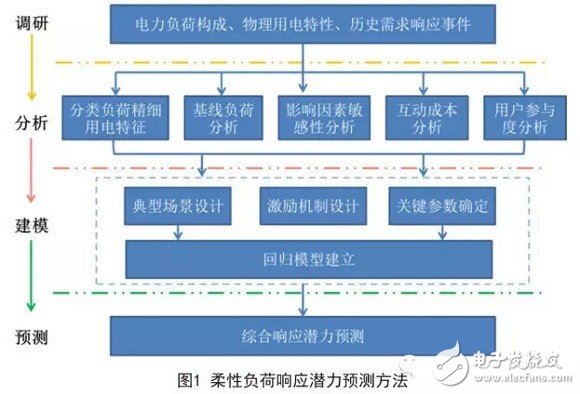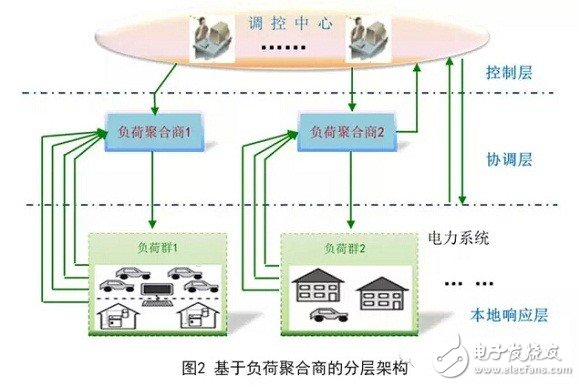As a supplement to power generation dispatching, flexible load dispatching can be used to cut peaks and fill valleys, balance intermittent energy fluctuations and provide auxiliary services, which is conducive to enriching the regulation of grid dispatching operations, and has become a hot spot at home and abroad.
1. Research backgroundAs a supplement to power generation dispatching, flexible load dispatching can be used to cut peaks and fill valleys, balance intermittent energy fluctuations and provide auxiliary services, which is conducive to enriching the regulation of grid dispatching operations, and has become a hot spot at home and abroad. “Flexible load†can be defined as the load that varies in the specified interval or transferred between different time periods, including adjustable load or transferable load with demand elasticity, electric vehicle with two-way adjustment capability, energy storage, and energy storage. , as well as distributed power supplies, micro-networks, etc. In the traditional power generation dispatching, the unit needs to respond completely according to the regulation and control instructions, and the flexible load scheduling needs to minimize the impact on the normal power consumption of the user while meeting the requirements of the power grid dispatching command. Flexible load dispatching in the development of the power market in Europe and the United States is characterized by demand response, focusing on the guidance of power users and user satisfaction. China is currently in the initial stage of market development, and still lacks complete market operation rules and electricity price formation mechanism. It is still unable to adjust market supply and demand in a timely and effective manner through economic means. Load dispatching is more represented by time-of-use electricity price and orderly electricity use. Demand side management emphasizes the security of the grid under a centralized dispatch system.
2. Review of load scheduling researchIn recent years, experts and scholars at home and abroad have carried out a lot of research work on flexible load response potential, scheduling mode, response behavior modeling and scheduling architecture.
The main steps of load response potential assessment include determining the type of research object and demand response project, analysis of load electricity characteristics, classification of demand response project participation rate, price elasticity calculation and response potential evaluation, focusing on price elasticity calculation method for segmented user groups. . The load response potential is closely related to the operating conditions of the power grid, the changes of the external environment, the consumer's electricity consumption psychology, and the state of the user's power consumption before the response. At present, the evaluation of the response potential of the load under a specific operating condition is relatively rare.

The load scheduling model focuses on the power price mechanism, contract mechanism, demand side bidding, and orderly power usage. Power companies can guide most flexible loads by setting reasonable price, but it is difficult to accurately schedule them. The load scheduling based on contract mechanism has high reliability and can directly participate in scheduling planning. Demand side bidding gives power load and generators equal bidding. Rights, but the requirements for market development are high; the orderly electricity use mode commonly used in China is conducive to ensuring the safe operation of the power grid, but there is still insufficient consideration for the interests of users. In general, the uncertainty of load self-response behavior, the coordinated scheduling of flexible loads at different time scales, and the decomposition and coordination of multiple types of flexible loads need further research.
In the aspect of load response behavior modeling, the response model should be able to take into account the impact of factors such as electricity price, incentives, consumer psychology, and user satisfaction on user response behavior, and facilitate the acquisition of timing characteristics of response behavior. From the perspective of grid optimization and dispatching, the grid company needs to compensate the flexible load involved in the dispatch according to the contracted incentive rate or the clearing price of the electricity market, involving the dispatching cost, user participation satisfaction, grid security constraints, etc. Load response is used as a decision variable in the optimization model.
The load scheduling architecture includes a centralized, distributed, and load aggregator-based layered architecture. The centralized architecture is directly issued to each load by the grid dispatching center, which is not feasible in actual grid dispatching. The distributed architecture has the advantages of small investment, flexible communication and control, but the completely distributed distributed architecture faces the problem of excessive control or insufficient control, and it is difficult to achieve system-level control objectives. The hierarchical aggregator architecture based on load aggregator has both the overall coordination capability of the centralized architecture and the decentralized autonomy of the distributed architecture. It is especially suitable for small and medium-sized workloads such as residents and businesses to participate in scheduling operations.

At present, there are still some outstanding problems in the research of flexible load scheduling mode and control strategy.
1) Further research is needed on the uncertainty of load self-response behavior, especially the influence of the uncertainty of the aggregate response of a large number of flexible loads based on electricity price on grid dispatching, and how the flexible load dispatching and conventional power generation are taken into account after uncertainty The scheduling is coordinated.
2) conventional power generation schedule includes Recently, real-time scheduling days and AGC control and a plurality of time scale, how the flexible load from the prediction error, response characteristics, the ability to regulate adjustment range, cost and the like coordinated scheduling time scales involved in different scheduling further Further analysis and research are needed.
3) The problem of decomposition coordination of different types of flexible loads is not discussed in depth. There are many types of flexible loads, including large users with voltage levels above 110kV, and small and medium loads with large number, wide distribution and different response characteristics. At the regional power system scheduling level, only the distribution network participating in dispatching can be given. The scheduling plan and spare capacity arrangement of the special-purpose users, large users, and load aggregators cannot be decomposed into each load.
4) The research results focus on maintaining the system's active balance. The research on the flexible and reliable control of the flexible load as a control means is still very limited.
3. Further research direction1) Flexible load comprehensive response modeling technology. Power grid dispatching is more concerned with the comprehensive response potential of the overall load of distribution network, special-purpose users and load aggregators. How to establish a reasonable and effective flexible load multi-form and multi-response comprehensive prediction model is a flexible load dispatching technology promotion basis.
2) Multi-time scale interactive trading mode design. Reasonable interactive trading mode is the key factor affecting the operability, operation efficiency and efficiency of flexible load participation in power grid dispatching. The exact operating state of the power grid cannot be known in the medium and long-term time scale. The interaction mechanism design should be based on price guidance. real-time scale grid operation state has been able to accurately informed, less uncertainty, may develop a more refined interactive trading mechanism.
3) Multi-time scale load coordination control technology. Due to the uncertainty of intermittent energy and load response, it is necessary to carry out rolling correction of the planned day according to the rolling refresh load and wind power forecast data on the intraday and real time scales. This is the focus of flexible load dispatching technology research.
4) Centralized and distributed coordinated control technology. The flexible load mostly occurs in distributed dispatching units such as distribution network, special-purpose users and load aggregators. How to realize the coordination of control unit distribution autonomy and overall decision-making of power grid dispatching center is the key, including online dynamic equivalent construction of distributed control unit Modular and parameter fitting techniques, fast distributed computing techniques, distributed control units and dispatch centers coordinate optimization decision techniques.
5) Interactive benefit assessment techniques. It is necessary to decompose the evaluation indicators from multiple levels such as time, space and assessment objects, and construct multi-dimensional measurement indicators from the aspects of response characteristics, response process, response effect and response performance, and finally form a comprehensive evaluation index system suitable for load scheduling.
4. ConclusionFlexible load scheduling changes the operation mode of the traditional power grid “generation tracking load changeâ€. By guiding the flexible load to actively participate in the grid dispatching operation, it can effectively improve the power system's regulation capability and improve the safety and economy of the grid operation. Considering the status quo of China's electricity price policy, marketing model, and development needs, the following suggestions and ideas are for discussion.
1) Strengthen guidance from power companies and power users from the perspectives of safety, economy, energy conservation and emission reduction. It is recognized that flexible loads can participate in the dispatching operation of the power grid as well as the generator set and have sufficient advantages.
2) Develop a reasonable scheduling model based on regional power resource endowment and flexible load composition. In areas where wind abandonment and light abandonment are serious and energy-intensive load capacity is large, dynamic electricity prices and contracts can be used to guide high-energy-consuming loads to absorb renewable energy; in large and medium-sized commercial, public facilities and household load proportions In high areas, peak power prices, interruptible loads and other mechanisms are used to achieve peak clipping.
3) Improve the incentive compensation mechanism for flexible load participation in power grid dispatching as soon as possible, and construct a flexible load dispatch demonstration project.
5050 Single Color Led Strip ,Single Color Led Strip,Single Color Led Strip Lights,Single Colour Led Strip
NINGBO SENTU ART AND CRAFT CO.,LTD. , https://www.lightworld-sentu.com